|
The Haas-Lilienthal House
2007 Franklin Street San Francisco, California 94109 The wallcovering restoration in the famous Haas-Lilienthal House took place in the indoor/outdoor vestibule of the home. William Haas, a prominent grocery merchant, and his wife Bertha Greenebaum, built the popular and well-preserved Queen Anne Victorian in 1886. This home would later be associated with a famous clothing company when their son Charles married into the family of Mr.Levi Strauss. |
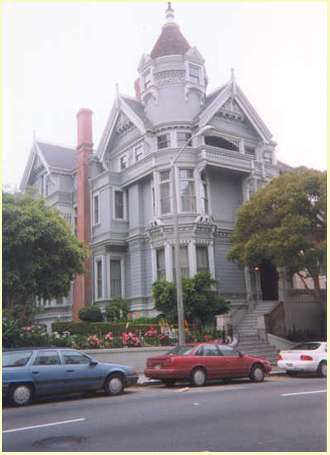
|
|
The wallcovering panels were located in between beautiful carved wood mouldings and trim in the regal vestibule. These panels, made of a canvas with simulated leather on the front, were able to sustain themselves in the climate of San Francisco because William Haas had pocket doors installed on the outside of the vestibule (one of the very first pocket doors of the time in the area). Through the years, the wallcovering panels had loosened and were releasing from the walls and ceiling. What appeared to be shrinkage of the wallcovering panels around the inner edges of the mouldings and trim could actually have been attributed to the wood mouldings contracting with the changing climate. |
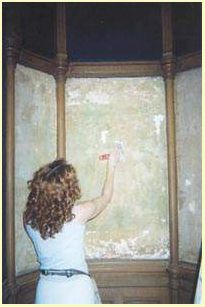
|
|
The wallcovering panels that could be removed without harm were completely taken down and laid flat. A map was drawn and the panels numbered and indicated on the map for accurate re-installation. Upon close inspection of the wall surface, I could see that the plaster had loosened in many areas, and the wall appeared dry. It was evident that a good part of the problem had been the unstable plaster underneath the wallcovering. I then proceeded to scrape away all the loose plaster, and next I applied a coat of oil based primer sealer. When the primer dried, I smoothed on a skim coat. This not only filled in the areas of plaster I had to scrape away, but also gave me the level and even surface I needed to re-apply the wallcovering panels. To insure a good seal of the prep work, I applied another coat of oil based primer sealer (a sandwich effect). |
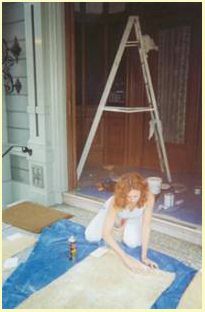
|
|
It was now time to re-install the wallcovering panels. I carefully turned the panels upside down, and proceeded to remove debris and as much of the old plaster stuck on the back as was safely possible. I then needed to check for adhesive compatibility, taking the utmost care in assuring the adhesives would not harm or discolor the antique panels. There was now one last step. Because the wallcovering panels had now become ill fitting around the wood mouldings due to probable shrinkage of the wood, I needed to somehow fill the gap (about 1/8" to 1/2" in some areas). I decided to mix a black paint that would match the faded black panels. I applied the paint with an artists brush all along the inside of the mouldings and trim. After the paint dried, I then re-installed all of the panels back to their appropriate places. The Haas-Lilienthal House is the only Queen Anne Victorian house opened to the public as a museum in San Francisco. Whenever you are in this beautiful city by the bay, a visit to this historic gem is a must. |
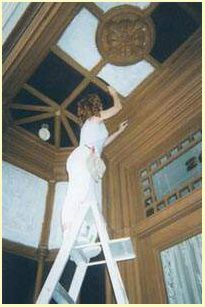
|
|
Stowell House
107 N. Orange Grove. Pasadena, California 91103 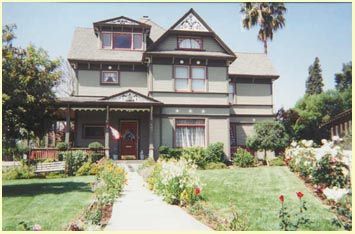
|
This beautiful Victorian Colonial Revival home was custom built for Mary Stowell in 1895. Originally located on South Los Robles Avenue in Los Angeles, the home ultimately became a rooming house. Left in terrible neglect, it was doomed to be demolished. In 1987 a couple and an investor purchased it for $1.00 on the condition that they would completely restore the house to its original splendor. Part of the restoration included relocating the home to its current location in Pasadena. |
|
Authentic historic reproductions of wallpapers of the era were custom made by
Bradbury & Bradbury Art Wallpapers, well known for being incredibly authentic in their reproductions
through their thorough research into wallpapers from the 19th and 20th centuries. Extensive
use of borders and frieze's were applied througout the house, as well as hand made screen-printed
wallpaper installed in almost every room of the three-story home. Special emphasis on the
beautiful coffered ceilings was acheived by installing unique borders and decorative
ceiling designs that were cut out by hand. |
|
Hotel Oceana 849 Oceana Ave. Santa Monica, California 90403 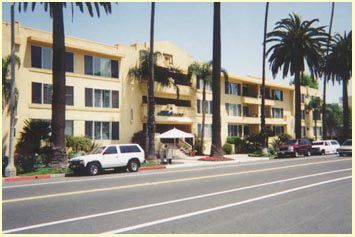
|
This charming ocean view hotel across from Palisades Park in Santa Monica is actually what I would call a "modern day" restoration. The hotel, built mid 20th century, was undergoing an extensive renovation, with the wallpaper being one of the most important cosmetic parts of the project. While some of the "faux finish" wallcoverings in the 65-suite hotel were partially replaced, my hand-painting the colors back into the wallpapers conserved most of the existing wallcoverings. |
|
The conservation consisted of custom mixing the three different colors of the "faux finish" wallcoverings, with special attention and research to finding the appropriate type of paint that would blend into the wallcovering material without leaving a shine or noticeable surface alteration. Using the technique of fine art restoration, I meticulously hand-painted the colors back into the areas that were scratched, scuffed, marked or worn out. |